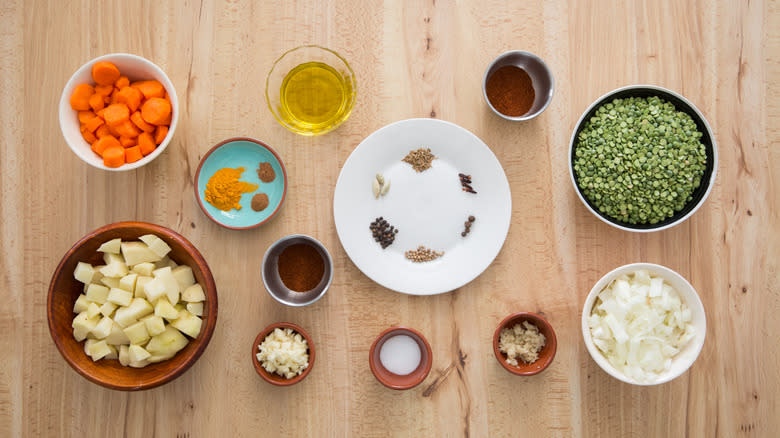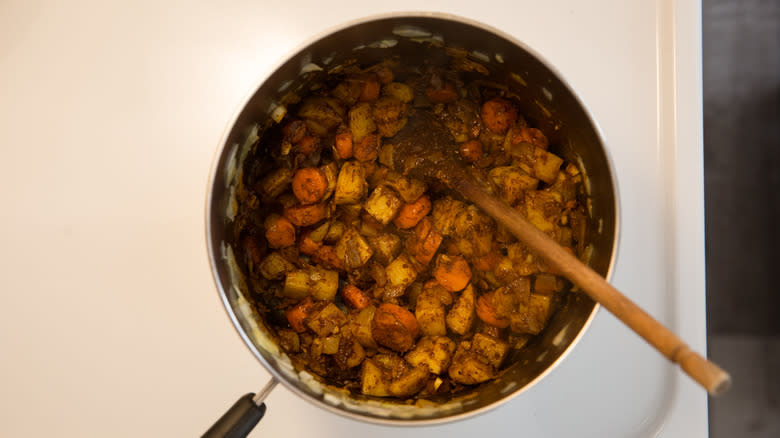Ethiopian-Inspired Berbere Split Peas Recipe

Ethiopian food is delicious, colorful, and flavorful, and it has the bonus of often being served on injera bread, which doubles as a plate and serving tool. This cuisine has gained popularity in the U.S., especially in dedicated communities like the Little Ethiopias in Washington, D.C., and Los Angeles. Recipes are easy to find for those who like to cook at home, and there is enough of a variety of meat, legume, and vegetable dishes to be suitable for people following different diets.
Recipe developer Michelle Bottalico has created an Ethiopian-inspired recipe featuring green split peas and an adaptation of the hot Ethiopian spice blend berbere. Instead of making a separate batch of berbere, whole and ground spices are added to the stew in the necessary quantities. Toasting the whole spices first adds even more flavor and will fill your kitchen with a lovely aroma. Hot, spicy food is common in Ethiopian cuisine, but you can dial the heat up or down by adjusting the quantity of cayenne pepper. The inspiration for this recipe is a spicy red lentil stew called misir wat. This one calls for green split peas and adds potatoes and carrots to the stew, meaning it can be served alone as a complete meal or with rice or Ethiopian injera bread, a soft flatbread made from teff flour. If you're new to Ethiopian cuisine, this is a good recipe to start with before enjoying the abundance of nutritious and flavorful dishes available.
Read more: 23 Types Of Potatoes And When To Use Them
Gather Your Berbere Split Peas Recipe Ingredients

For this recipe, you will need green split peas, which will make up the bulk of the dish. The distinctive Ethiopian spice blend berbere can easily have up to 20 individual spices, but we've narrowed it down to 11 for this recipe. Some are whole and will be toasted and ground in the beginning steps. The whole spices are black peppercorns, coriander, cumin, cloves, allspice, and cardamom. The ground spices are cayenne pepper, sweet paprika, turmeric, cinnamon, and nutmeg. Garlic, onion, and fresh ginger will also add flavor to the dish. Finally, you'll need olive oil, carrots, potatoes, and salt. Optional ingredients include lemon juice to squeeze onto the dish before serving as well as injera bread or rice, also for serving.
Step 1: Heat The Spices

Place the peppercorns, coriander, cumin, cloves, allspice, and cardamom in a dry frying pan, preferably cast-iron, and heat it on a medium flame.
Step 2: Toast The Spices

Let toast for 3–4 minutes, shaking the pan periodically to prevent burning, until the spices are fragrant and slightly browned.
Step 3: Grind The Spices

Remove from the heat and transfer the spices to a mortar. Grind the spices to a powder with the pestle, removing the cardamom pods as soon as they've broken open. Set aside.
Step 4: Heat The Oil

Heat the oil in a large saucepan on medium heat.
Step 5: Cook The Vegetables

Add the onion, carrots, and potatoes and saute, stirring occasionally, for 6–7 minutes.
Step 6: Add The Garlic And Ginger

Add the garlic and ginger and cook for 2 more minutes.
Step 7: Add The Spices

Transfer the ground spices from the mortar to the pan, and then add the cayenne pepper, paprika, turmeric, cinnamon, and nutmeg. Stir well and cook for 1 minute.
Step 8: Add The Split Peas And Water

Add the split peas and 4 ½ cups of water, stir, and bring to a boil.
Step 9: Cook The Stew

Lower the heat and let simmer, uncovered. Cook, stirring occasionally, for 40–45 minutes, or until the peas are tender, start to fall apart, and form a creamy mixture.
Step 10: Salt To Taste

Stir in the salt and taste, adjusting for salt if necessary.
Step 11: Serve The Berbere Split Pea Stew

Serve immediately with an optional squeeze of lemon juice and with injera bread or rice, if desired.
What Is The Berbere Used In This Ethiopian-Inspired Berbere Split Peas Recipe?

If you've eaten Ethiopian food, either at an Ethiopian restaurant or made from a recipe at home, you've likely come across bebere, an spice with origins in the 5th century. This reddish spice blend is ubiquitous in Ethiopian and Eritrean cuisine. The name comes from the Ethiopian word barbare, which was originally papare (pepper) in ancient Ethiopian. Barbare is translated as "hot" in English, and that's no coincidence. The bulk of berbere comes from cayenne pepper, and this results in a spicy mix.
Numerous other spices are combined with the cayenne pepper. The list often includes paprika, cumin, cardamom, allspice, cloves, fenugreek, coriander, black pepper, ginger, and cinnamon, among others, but don't expect it to taste the same every time, because the combinations change according to who is making it. Berbere will have the most flavor if you make it with whole spices, toasting them first until fragrant and then grinding them to a powder. It may seem like a lot of work, but if you make a big batch, you can keep it in a jar in the pantry and it will be available whenever you want to add serious flavor to your food.
Can I Substitute Ingredients In Ethiopian-Inspired Berbere Split Peas?

Since this recipe is already an adaptation of misir wat, you can substitute ingredients if you prefer. Yellow split peas, red lentils, or brown lentils will work, but check the cooking times for each legume. Red lentils cook faster, especially if they're split, so adjust the cooking time accordingly.
Spicy food is a hallmark of Ethiopian culture, and this often comes from the characteristic berbere spice used. Recipes differ, but most of the spice mixture is usually cayenne pepper, and this recipe is no exception. The 1 tablespoon of cayenne in this recipe is divided over 8 servings, and that may either be a little or a lot depending on who you ask. Feel free to dial that up or down according to your tastes. There are 11 other spices in the ingredient list, and they all come together to create a complex flavor in the style of berbere. It would be great to have them all, but if they are not available you can leave some out and increase the quantities of the others a little. If you can't find whole spices, you can use ground spices instead, but add them to the recipe in the later step with the other ground spices instead of toasting the powder. Finally, if you can't get 2 inches of fresh ginger, you can use 1 tablespoon of dried ginger instead.
Ethiopian-Inspired Berbere Split Peas Recipe

Prep Time: 5mCook Time: 60mYield: 8 ServingsIngredients
½ teaspoon whole black peppercorns
¼ teaspoon whole coriander seeds
¼ teaspoon whole cumin seeds
4 whole cloves
4 whole allspice berries
3 whole cardamom pods
¼ cup olive oil
1 large yellow onion, chopped
4 medium carrots, sliced
1 pound potatoes, cut into ½-inch cubes
4 garlic cloves, minced
2 inches ginger root, peeled and grated
1 tablespoon ground cayenne pepper (or less, to taste)
1 tablespoon ground sweet paprika
1 teaspoon ground turmeric
⅛ teaspoon ground cinnamon
⅛ teaspoon ground nutmeg
1 pound green split peas
1 teaspoon salt, or to taste
Optional Ingredients
Lemon juice
Injera bread
Rice
Directions
Place the peppercorns, coriander, cumin, cloves, allspice, and cardamom in a dry frying pan, preferably cast-iron, and heat it on a medium flame.
Let toast for 3–4 minutes, shaking the pan periodically to prevent burning, until the spices are fragrant and slightly browned.
Remove from the heat and transfer the spices to a mortar. Grind the spices to a powder with the pestle, removing the cardamom pods as soon as they've broken open. Set aside.
Heat the oil in a large saucepan on medium heat.
Add the onion, carrots, and potatoes and saute, stirring occasionally, for 6–7 minutes.
Add the garlic and ginger and cook for 2 more minutes.
Transfer the ground spices from the mortar to the pan, and then add the cayenne pepper, paprika, turmeric, cinnamon, and nutmeg. Stir well and cook for 1 minute.
Add the split peas and 4 ½ cups of water, stir, and bring to a boil.
Lower the heat and let simmer, uncovered. Cook, stirring occasionally, for 40–45 minutes, or until the peas are tender, start to fall apart, and form a creamy mixture.
Stir in the salt and taste, adjusting for salt if necessary.
Serve immediately with an optional squeeze of lemon juice and with injera bread or rice, if desired.
Read the original article on Tasting Table


